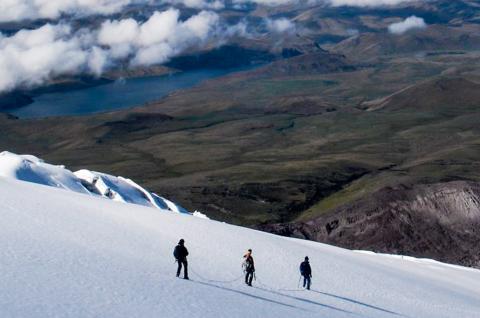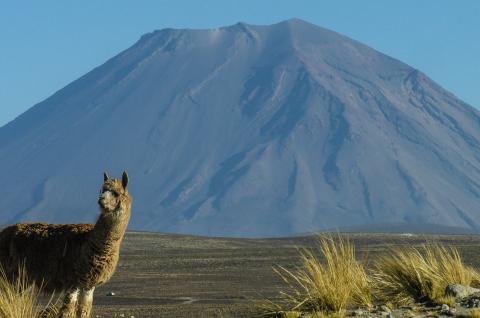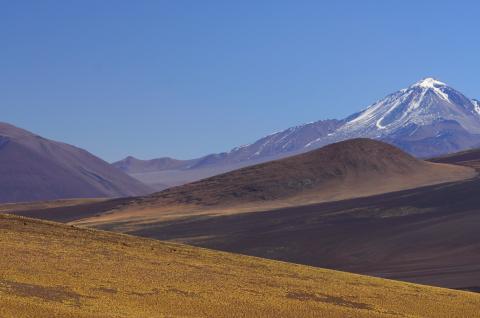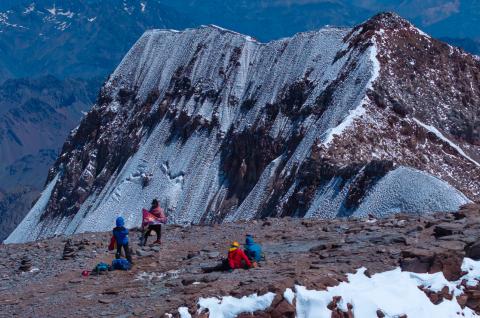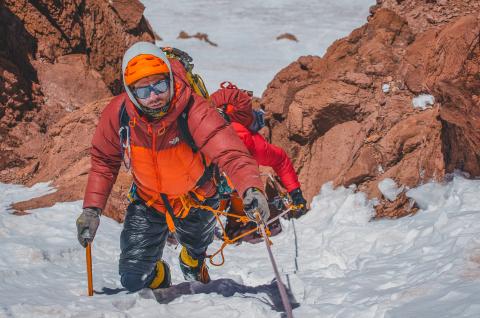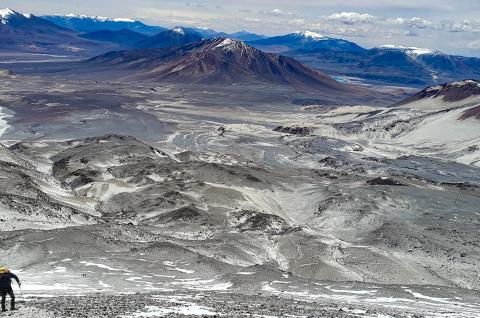€400 discount for booking before the end of May
Highlights
- America's highest peak at almost 7000 m
- One of the summits in the 7 Summits challenge
- 7000er summit accessible with no mountaineering technique
- 1 guide for 3 participants maximum on summit day
- 3 nights at Confluencia (3360 m) for better acclimatization
- Guaranteed departures from 2 participants
- Hyperbaric chamber and Ifremmont assistance
This mythical 7000-meter peak, the highest in South America, presents no particular technical difficulties on the normal route. It is part of the “7 Summits” challenge, which makes it such a success and attracts mountaineers from all over the world. A return trip to the foot of the mythical south face at Plaza Francia and the ascent of Cerro Bonete (5100 m) give us the opportunity to prepare well for our acclimatization. Due to its location at the tip of the southern hemisphere, where the climate is particularly dry, the route is snow-free most of the time. The northwest ridge is the normal route to the summit. The main difficulty lies in the very high altitude and the often violent winds that sweep across the summit, with an average summit success rate at 50% only.
Overview
Nicknamed the Colossus of the Americas, Aconcagua was first climbed in 1897 by Swiss guide Matthias Zürbriggen. His climbing companion, the American Edward FitzGerald, who sponsored the expedition, had to give up at around 6600 meters, not far from the famous “Canaletta”. Today, many people attempt to climb this almost 7000-meter peak, which has the unique feature of requiring no previous technical mountaineering experience. Indeed, the particularly dry climate of this part of the Andes means that there are no glaciers on the north and west faces. With the exception of a few rare snowfalls, the climb to the summit is a dry one, via the normal route. The approach hike requires four days to reach the base camp at Plaza de Mulas (4350 m). This is a very comfortable base camp, providing a good rest between the various days spent acclimatizing on the mountain between the various altitude camps. A preliminary ascent of Cerro Bonete (5100 m), opposite Aconcagua, gives you the full measure of the climb. Three altitude camps are required to complete the ascent in optimum conditions:
- Nido de Condores at 5560 meters
- Plaza Canada at 5050 meters
- Colera at 5970 meters
Aconcagua can be climbed by four different routes:
- via the classic north-west face, starting from Plaza de Mulas (the historic route of the first ascent), which is what this trip notes is all about: the normal Aconcagua route;
- by traversing the eastern slope, known as the Aconcagua traverse ascent, which you can discover here;
- via the east face, the ascent via the Polonais glacier, a more alpine route, to be discovered here and finally,
- via the South Face, a highly committed route for professionals, which is now almost non-existent due to mountain conditions.
For information, the Aconcagua traverse from the east side, starting from Plaza Argentina, is a slightly more demanding route than the normal route, due to the long crossing at altitude between Camp 2 at 5486 meters and Camp 3 of the normal route, Colera (5970 m), which you reach before engaging in the summit ascent. It is, however, wilder and less frequented.
The ascent via thePolish Glacier, another route, follows the same ascent itinerary as the traverse, but at Camp 2 (5486 m), we divert to a dedicated Camp 3 (5863 m) at the foot of the glacier, which we climb to the summit and back. This means almost 1100 meters on a relatively steep glacier (40 to 55°) in snow and ice, which requires a little mountaineering experience. In conclusion, the traverse passes close to the Polish Glacier, but does not use it!
Discover our animated itinerary for climbing Aconcagua via the normal route.
Itinerary
Day 1: Departure from Europe
Day 1
Flight to Mendoza via Buenos Aires or Santiago de Chili.
Day 2: Arrival in Mendoza
Day 2
We are met at Mendoza airport by our correspondent. Transfer to town and check into hotel. First contact with the guide to confirm the next day's schedule. We take advantage of the remaining free time to stroll through the lively, shady streets and squares. And on this first evening in Argentina, we have to try the legendary bife de chorizo.
Day 3: Mendoza
Day 3
Appointment with the guide, who gives us our precious permit, explains how the trip will work and checks each participant's equipment. This is also the time to make final purchases or rent equipment. Afternoon and evening free to wander around Mendoza.
Day 4: Mendoza – Penintentes – Puente del Inca – Confluencia
Day 4
We leave the things we are not taking, passing through the town and then the vineyards, before reaching Potrerillos and its artificial lake (leisure centre) on the Rio Mendoza, and then the final village of Uspallata. We now enter the Rio Horcones valley, which leads to the Chilean border. We arrive at the small station of Penitentes. We leave the things we are not taking with us on the ascent in a locker in the warehouse. We need two waterproof soft bags, one to be taken directly by mule to base camp and wait for us there, the other to follow us during the acclimatization trek. Once the mules are loaded, a final short 15-minute transfer takes us to Horcones (2850 m), the trailhead to base camp. Park rangers check our permits. The approach hike begins, on a gently sloping trail that leads to Confluencia, the first camp on the way to Aconcagua (3390 m), in the beautiful Horcones valley.
Day 5 : Confluencia – Plaza Francia (4000 m) – Confluencia
Day 5
The day's main objective is acclimatization. Early in the morning, in a calm, cold atmosphere, we make our way into the valley of the upper Horcones glacier. Over long sandy beaches and small jumps, we climb steadily up to the base camp on the south face, at an altitude of 4000 meters. It is an impressive sight. The first ascent of this formidable wall was made in February 1954 by six French climbers led by Robert Paragot. After a quick picnic, we return to Confluencia.
Day 6: Rest day in Confluencia
Day 6
Another essential day for acclimatization. These three nights spent at almost 3400 meters are perfect for our adaptation to altitude.
Day 7: Confluencia – Plaza de Mulas base camp
Day 7
Today is going to be a long day. We soon cross over to the opposite bank of the rio, and a short climb takes us to an immense plain made up of a succession of stony flats and constrictions until we reach the start of the real climb marked by large stone monoliths at around 3800 meters. Slowly, we make our way to Plaza de Mulas (4350 m). Arrival at base camp is like a reward. Our partner and his team welcome us like old friends. We can take a hot shower before dinner. Free Internet access allows us to keep in touch with our loved ones.
Day 8: Plaza de Mulas
Day 8
We take another day off to acclimatize. To check that our acclimatization is correct, the park rangers give us a test with an oximeter to check the oxygen saturation in our blood as well as our heart rate. This is not a day for doing nothing, it is a day spent making ourselves comfortable, sorting out our belongings, wandering around our little environment and socializing. We can also stay and read in the mess tent or practice a few exercises on the yoga mats set up in the heated lounge tent. But whatever we do, we must remember to stay hydrated.
Day 9: Ascent of Cerro Bonete (5100 m) – Plaza de Mulas
Day 9
An early start for our first effort at altitude. After crossing under the glacier, we set off on a steep and not always pleasant trail, always at a slow pace to work on our acclimatization. We reach Cerro Bonete at 5100 meters. It faces the Aconcagua. Breathtaking view of the west face. A good opportunity to test our organism before getting down to business.
Day 10: Plaza de Mulas – Plaza Canada (5050 m) – Plaza de Mulas
Day 10
We set off for our first high altitude carrying. We leave the camp and soon come across an excellent track that zigzags over 1000 meters of ascent to the Nido de Condores. On this first day, all we can do is reach Plaza Canada at 5050 meters, where we set up our first camp before descending to Plaza de Mulas.
Day 11: Plaza de Mulas
Day 11
Treat yourself to a hot shower, welcome after completing the first stage of the climb.
Day 12: Plaza de Mulas – Plaza Canada
Day 12
We leave the base camp and head for Plaza Canada, the first stage of our ascent and this time our first night at over 5000 meters.
Day 13: Plaza Canada – Nido de Condores
Day 13
We continue on the good track that zigzags up through the scree. Breathlessness is the word of the day, and we have to take things slowly. Finally we reach the vast flat area known as the Nid du Condor, where we set up our second camp.
Day 14: Nido de Condores – Colera
Day 14
We reach our last camp, the highest of the climb. Dinner at almost 6000 meters. If the wind is not too strong, this camp is a magnificent lookout point.
Day 15: Ascent of Aconcagua (6962 m) – Descent to Colera
Day 15
We set off early to make the most of the (long) day. We take a very light rucksack (water, food, some clothes, camera). The path is not easy, with frozen rock and earth. We reach the “Independencia” site at 6300 meters. Here we begin a long traverse above the Gran Arracareo. We soon pass the “Portosuelo del Viento” rocks, a veritable wind tunnel for testing aerodynamics, and arrive at the entrance to the Canaleta at around 6600 meters. The most demanding part begins: the slope is steep, the stones and boulders are like icebergs on the sea, and we have to concentrate to move forward. It's on this section that, on the instructions of our guide, we can put on our crampons if the terrain is icy. And when we get close to the pass, we finally find less difficult terrain to progress below the ridge and reach the summit. If it is not too cold, we make the most of the moment and take a few photos. Then it is time to descend to Colera to leave the critical altitude zone. Allow 8 to 12 hours for this day's ascent to the summit.
Days 16 & 17: Extra days
Day 16
To ensure the success of the expedition, we have added two extra (contingency) days in case of bad weather. The weather may be fine at base camp, but the wind at altitude may prevent any progress.
Day 18: Colera – Plaza de Mulas
Day 18
We begin the long descent to base camp, where a well-deserved festive dinner awaits us.
Day 19: Plaza de Mulas – Puente del Inca – Mendoza
Day 19
We are in for a real tumble. A long day's walk to separate us from Aconcagua takes us down to Puente del Inca. Then we hit the road for Mendoza, where the heat is back. After a good shower, we enjoy a good asado with a good wine to celebrate our return.
Day 20: Return to Europe
Day 20
Three hours before our flight, departure from our hotel and transfer by private vehicle from Mendoza to the airport. Domestic flight Mendoza – Buenos Aires or Santiago and connection to Europe.
Day 21: Arrival in Europe
Day 21
END OF EXPEDITION
For reasons that cannot be foreseen at this stage, such as unpredictable weather, the physical fitness or lack of fitness of participants or other circumstancess (customs formalities, road conditions, traffic, landslides, force majeure, etc.), your expedition leader may have to adapt the program, if necessary, to ensure the smooth running of your trip. He remains the sole judge and the one who guarantees your safety. Activity times are given as an indication and may vary from one participant to another.
The itinerary for all our expedition programs, or the ascent program for our high-mountain expeditions, are given here as a guide only. They are flexible enough to adapt to weather conditions with a few contingency days. In any case, you should follow the recommendations of your guide, who may suggest that you cancel your expedition due to weather, safety or physical conditions.
It is important to remember that this is a truly unsupported expedition, and that anything can happen. Expeditions Unlimited, your expedition leader, your guide or our local teams can in no way be held responsible.
Any costs incurred as a result of a change in the expedition schedule (extra nights' accommodation, extra flights) will be borne by the participants and not by the organizers. "Contingency days" refer to the expedition in the strict sense of the term (base camp/base camp in the mountains, departure point/exit point on a traverse, etc.).
Any early return of the expedition or of certain members only (early success, abandonment, etc.), generating costs for accommodation, meals, changes to air tickets or other activities not provided for in this program, will be charged in full to the participants.
Trip notes
Guiding
All the Argentinean mountain guides on our team have undergone the compulsory training required to work at altitude. Two institutions are authorized in Argentina to provide this training: the EPGAMT (Escuela Provincial de Guias de Alta Montagna y Trekking) and the AAGM (Association Argentina des Guides de Montagne), itself affiliated since 1984 to the UIAGM (Union Internationale des Associations de Guide de Montagne), whose role is to ensure that all certified guides worldwide have the same level of competence. We strive to work with the same guides for as long as possible, year after year, as their experience over the years reinforces their skills. All our guides are Spanish- and English-speaking. A French-speaking guide is available on request, but must be booked well in advance.
For the expedition, there is one main guide for the group. This guide may be assisted by one or more assistants, depending on the size of the group. A Whatsapp group will be set up 48 hours before departure. This group will be used to provide important pre-departure information, as well as meeting places and times. Conversation will generally be in English.
The ratio of mountain guides to participants in the group changes as the group progresses:
- Up to base camp, 1 guide for every 6 participants;
- for rotations from base camp to high altitude camps, 1 guide for every 4 participants;
- for the Summit Push, 1 guide for every 3 participants.
The porters all have the national mountain guide diploma. Their presence enables us to reduce the weight of loads to be carried. In addition to these porters, there are “water carriers” who carry drinking water to the high-altitude camps.
Finally, the mules that carry our luggage and all our collective equipment are indispensable. We take great care of them.
For unpredictable reasons at this stage, like adverse weather conditions, insufficient physical condition of participants, insufficient competencies of participants related to the intended activities, your guide may decide to adjust the intended program and/or activities. At all times, his decision will be final on all matters likely to affect the safety and well-being of the trip.
Difficulty level
Level rated: difficult
This program is aimed at participants in good physical shape, with a significant sport practice, endurance in particular, holding a strong mental to face difficulties that are unforeseen by nature.
Cumulative daily ascents and descents can reach 1000 meters. We operate in isolated environments where the safety of the group depends on the endurance and autonomy of each participant. Team spirit is essential in these ambitious projects, which are aimed at very good sportsmen and women.
Collective equipment is carried by mule to the base camp (Plaza de Mulas).
Beyond the base camp, each participant must carry his or her own belongings and some food. Most of the collective equipment and the water needed for the high-altitude camps are carried by porters (one for every four participants). With the equipment and clothing you will need for the climb, your pack should weigh no more than 14 or 15 kilos. Add to this some of the collective gear (tent, stoves, etc.), and your pack can reach 18 to 22 kilos. It is possible to hire the services of an individual porter (for up to 20 kg) between the base camp and the last camp. The price then varies according to the weight and the route for which the porter is hired. Expect to pay between 500 and 1,500 USD in cash on the spot.
Participants are responsible for setting up and dismantling the tents at altitude camps.
The ascent of Aconcagua is not difficult, and this is its weakest point, presenting a real danger if you do not prepare seriously. It is an adventure in the world of very high altitude, and you need to think seriously, well in advance, about how to manage this experience. To do this, we strongly advise you to devote a day or a weekend (date to be agreed) to establishing rules that will serve as benchmarks for you and guarantee your safety.
Preparatory courses for high mountain/polar environments as part of our Adventure School can be a great asset, both for building confidence and for gaining autonomy.
For this expedition, you benefit free of charge from pre-expedition teleconsultation and membership of the H24 7/7 medical service for the duration of the expedition, set up with our partner Ifremmont. See below for details.
Technical difficulty
Mountaineering level: F like... Easy (Facile in French!)
In this program, the use of mountaineering equipment (crampons, harness, ice ax, ropes, etc.) is necessary but the route covered does not involve any technical difficulty. It is therefore aimed at beginners or even participants who have never practiced. Clearly, a little prior experience in the activity can be interesting, knowing how to equip yourself, knowing how to tie a few essential knots. The mountaineering courses at our Adventure School from three days are for you. And this technical rating applies of course to normal weather conditions: the difficulty can increase in the event of bad weather conditions, fresh snow on rocks, insufficient or lack of quality of the ice, etc. Likewise, the situation changes radically, for the same technical level, with the altitude, the weight of the bag, the lack of equipment on the route, the fatigue associated with the approach if it is long, the environment if particularly hostile, etc.
Meeting point
We meet in Mendoza where we are welcomed at the airport by our local teams.
Given the diverse origins of the participants on this trip, international outward and return flights are not included in this package. In most cases, we book flights on your behalf to ensure that the whole group arrives at the destination at the same time. We do not charge any fees for these air bookings. Please do not hesitate to contact us. If you book your own tickets, we will advise you on the ideal flight schedule to enable all participants to arrive within a reduced time frame. At the very least, you need tickets that can be modified.
Accommodations
MENDOZA AND TREKKING
In a good-category hotel in Mendoza, preferably the Diplomatic Hotel or similar. In 3-seater dome tents used for two participants for the approach walk to the base camp, Plaza de Mulas. A single room is possible with a supplement.
BASE CAMP
Spacious, heated mess and lounge dome tents. Toilet tents with hot showers. 3-seater dome tents used for overnight stays by two participants. A single tent is available at extra cost. In the dome tent or in a dedicated tent, you can recharge your 110 v, 220 v and 12 v electrical appliances. Free satellite wifi via starlink.
HIGH ALTITUDE CAMPS
3-person dome tents used for two participants at each altitude camp. Each altitude camp has a dedicated dome tent reserved for guides and porters. In it, you'll find a VHF radio and a USB charger, which can be made available subject to good weather conditions and crowds.
Meals
MENDOZA AND TREKKING
Food in Argentina is excellent, but very meaty. Vegetarians are not catered for, but vegetarian menus are available on request when you register. At base camps and in some camps, it is not uncommon to enjoy a BBQ.
Fresh, nutritious food is provided daily, prepared by cooks. We take our meals in a dome tent. The food is varied and includes vegetables, meat and fish. Throughout our stay at base camp, food, tea and coffee are provided free of charge.
BASE CAMP
Fresh, nutritious food is provided daily, prepared by in-house cooks.
HIGH ALTITUDE CAMPS
Food is always prepared by us. We provide a picnic lunch. However, we suggest you bring a few treats from France, which you'll particularly appreciate at high altitude. In the evenings and mornings, food is prepared by the guides. Sometimes freeze-dried or cooked depending on altitude and weather.
DRINKING WATER
Drinking water is provided throughout. This is an increasingly important issue, given the dramatic reduction in glaciers and rivers on Aconcagua. This water is reserved exclusively for culinary use and is used to fill our water bottles. This water is sometimes carried (from base camp to camp 1, for example) or made up of melted snow. It is not possible to wash with this water, which is becoming increasingly rare on the mountain.
PROVISIONS & SNACKS
At base camp, there's an all-you-can-eat food buffet (chocolates, dried fruit and chocolate bars, powdered fruit juice, etc.). In the high altitude camps, it is also possible to stock up, but on a more limited scale.
Transfers / Transport
Transfers from and to the airport are provided by minibus. The route is planned in 4x4 or minibus.
Group size
The group is composed of 1 to 15 participants maximum.The departure is an international departure, sometimes involving several nationalities, and is not exclusive to Expeditions Unlimited. The maximum number of participants in the group is often 8, or even 10, rarely more. That said, to leave a margin of safety, the logistics organization can theoretically plan for a group of up to 15 participants. The number of participants is deliberately limited to allow for greater immersion, to avoid embarrassing our hosts, and to develop freedom and flexibility. However, the maximum number may be exceeded if the last person to register wishes to travel with one or more other people. The services will not be modified, and the conditions of the trip will remain the same.
Equipment
OXYGEN
Below 7000 meters, oxygen is not justified. However, it is available at base camp and in the high altitude camps for medical use. Oxygen can be used during the summit push on special request and at extra cost. It is best to make the request a month before departure or, at the latest, at base camp (but there is no guarantee of availability). Approx. US$1,000 per cylinder, to be paid in cash on site.
SAFETY AND COMMUNICATION
All our camps are linked by radio. At base camp, a permanent link is maintained with Penitentes. Free wifi at base camp.
MOUNTAINEERING AND CLIMBING EQUIPMENT
The personal equipment list is given at the end of this document, in the “Personal equipment” section.
We recommend that you leave home with all this equipment. For this reason, we offer all cold-weather equipment and technical climbing gear for hire (please consult us).
If you are missing something, you can always rent equipment on site, but availability, quality and price (hyperinflation) are not guaranteed, especially in high season and/or for unusual boot sizes. The four equipment stores in Mendoza are likely to offer the following for hire and/or purchase:
- Mountaineering boots
- Down jacket -30°C
- Down gloves
- Mattress
- Crampons
- Expedition rugsack
- Ice axe
- Sleeping bag
Our commitments to sustainable development
Our commitment to a better planet has been a reality since the beginning of our story but we always need to do more and better. Please find out more about our charter and our commitments in terms of sustainable development. We have drafted our charter and take action through six themes on which we act as concretely as possible, most often with you: social equity and cultural respect, preservation of water, waste management in expedition, protection of biodiversity, raise public awareness on these subjects and finally, the optimization and recovery of CO2 emissions.
Regarding carbon emissions, most of which are due to air travel, we calculated and communicated in 2018 on the carbon footprint of each of our programs, expressed in tonnes of CO2.
These calculations made us aware of the importance of the total carbon emissions generated by our activity. Also, we have committed in 2022 to a carbon reduction that we believe is unprecedented in the tourism industry, aiming to reduce the total emissions of our activity by 5% per year, taking 2019 as the reference year (3,430 tonnes of CO2). This commitment is in line with the trajectory of the Paris climate agreements of 2015, the current benchmark. Thus, in 2030, we commit ourselves not to exceed 2,160 tonnes of C02. Thus, our maximum “carbon” budget for 2024 is 2,950 tonnes and for 2025, this budget will be reduced to 2,800 tonnes. And so on until 2030. To find out more about all of our calculations and our commitments in terms of reducing our carbon emissions.
In addition, since 2019, we have been encouraging you when you book for your journey to contribute with a donation to an independent NGO, among the two we have selected that share the commitments made in our charter. We matched the amount of this donation to this program's carbon footprint. Thus, the journey you are considering generates 4,37 tons of CO2, which corresponds to a 100% donation of €131 for an estimated value today of €30 per tonne of CO2. This donation remains of course optional and you can decide to give between nothing and 100% of this amount. Since 2019, including covid years of 2020 and 2021, we have been able to collect thanks to you nearly €7,000 for these associations.
Please do not hesitate to come back to us with any questions you might have regarding this carbon footprint mechanism, our other sustainable développement commitments or even to share with us your experience through a chat or a mail at contact@secret-planet.com.
Mot de l'expert
A challenge, perhaps, for anyone who, like me, is not a mountaineer, but loves challenges and hypoxia. A unique opportunity to get close to the gods of altitude without having to put on crampons. Perhaps also the starting point for the Seven Summits challenge. Conceived by Dick Bass and Franck Wells in 1985, the 7 Summits challenge involves climbing the highest peak on each of the seven continents. Everest in Nepal/China, Aconcagua in Chile, Mount Denali in Alaska, Kilimanjaro in Tanzania, Elbrus in Russia, Mount Vinson in Antarctica, Carstensz Pyramid in Indonesian Papua.
Reviews
Maïlys H.
Dear Maïlys, thank you for your wonderful feedback, and well done to you and your very friendly group. The local team loved taking care of the four of you.
Clémence L.
Dear Clémence, thank you for this wonderful feedback and congratulations to you and the group for this beautiful ascent of Aconcagua, where conditions are very often very tough.
Adrien S.
Dear Adrien, thank you for your kind feedback on your climb and our warmest congratulations on this beautiful and hard climb achieved with success
Cécile G.
Hello Cécile. Thank you very much for your review according to the Aconcagua Climb expedition in Argentina. We're delighted to hear that everything went well, despite the political situation. It is true that you were fortunate to have a French-speaking guide, Hernan, as the departure had been guaranteed well in advance. We look forward to talking new projects with you!
Franck F.
Thank you Franck for your review and congratulations on a the successful climb. It is never a given, there are always so many unpredictable factors! Well done! Looking forward to hearing from you on new adventures !
Departures and pricing
Please find below all dates and prices for this expedition. Prices are quoted "from" and may be adjusted notably according to the number of participants (see trip notes for details). Please note that dates and prices for years beyond 2024, when given, are for guidance only and are subject to change and readjustment to take account of current economic realities.
No date works for me!
I initiate a new datePrice includes
- 3 nights' accommodation in a 5-star hotel in Mendoza with breakfast in a double room
- Airport/hotel transfers in Mendoza
- Transfers by private vehicle between Mendoza and the start/return point of the trekking tour
- Full-board meals during the trek
- Carrying of personal belongings by mules during the trek and to base camp
- Accommodation in triple tents for two people during the trek
- Base camp equipment: kitchen tent, mess tent, tables and chairs, toilet tent, shower tent
- Base camp kitchen team
- Base camp triple tent for two people
- Double high-altitude tents, high-altitude food, stoves and fuel
- Insurance for guides (evacuation, hospitalization, medical expenses, life insurance), cook and helpers
- 1 experienced English-speaking local mountain guide for 4 participants (1 French-speaking guide on some departures, please consult us)
- 1 porter per 4 participants for collective equipment (20 kg maximum per porter)
- Drinking water carriers at altitude camps
- Collective climbing equipment
- Satellite telephone (for rescue purposes only)
- Electricity at base camp for charging small electronic equipment (cell phones, ordinary cameras, etc.)
- Weather forecast services
- Free internet and wifi at Confluencia and base camp
- Medical follow-up by Ifremmont during the expedition (see above)
- Live coverage of the expedition for your community (supply of InReach beacon & subscriptions)
- Unlimited text messages to your personal contacts (InReach beacon)
- Preparatory videoconference meetings (in France)
Price does not include
- International return flight to Mendoza
- Taxes and climbing permit, adjusted annually by the Argentinian government (850 US$ permit fees in 2024/25)
- Consular fees (visa)
- Any customs taxes upon arrival in Argentina
- Import taxes, if any, for satellite phones, professional communications equipment and commercial filming
- Any additional hotel nights in Mendoza (over 3 nights)
- Any helicopter transfers
- Meals in Mendoza other than breakfasts
- Expenses related to a shift in the expedition schedule (additional nights' accommodation beyond 3 nights in Argentina, meals, air supplements)
- Expenses related to the early return of the expedition or of certain members only (abandonment, etc.), generating costs for transfers (porters, guide, vehicle, plane, etc.), accommodation, meals, changes to plane tickets or other activities not included in this program
- Tips for guides and local staff, to be shared with other participants to your satisfaction
- Any personal communications by satellite phone (to be paid locally)
- Personal equipment including individual high-altitude gear
- Rental of personal high-altitude equipment, subject to availability
- Pre-acclimatization protocol developed with Ifremmont and physical and/or mental preparation with a specialist Sport Altitude coach as described above
- Drinks and personal expenses (sightseeing, cabs, souvenirs, dry-cleaning, etc.)
- Travel and expedition insurance (assistance, evacuation and repatriation)
Your custom expedition
We put our expertise, our knowledge of the terrain, our creativity, our experience, the quality of our guides and the reliability of our partners at your service to build your custom expedition. We can also personalize an expedition to your wishes as soon as you form a "closed" group, whatever the number of participants.
This means that, unless you authorize us to do otherwise, no outside participants join you, and we can personalize your expedition by adapting it to your own pace, with the program extensions you desire, a higher level of comfort, certain activities, other encounters, etc.
Every expedition of this type is subject to a specific quotation. To get in touch with us now, please fill in the short questionnaire below. One of our experts will get back to you to refine your request and make you a proposal.




















